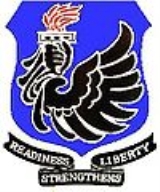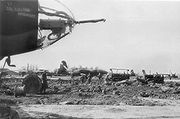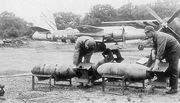
394th Bombardment Group
Encyclopedia
The 394th Bombardment Group is an inactive United States Army Air Force unit. Its last assignment was with the XII Fighter Command stationed at AAF Station Kitzingen, Germany. It was inactivated on 15 February 1946
During World War II the unit was deployed to Western Europe and fought in combat with Ninth Air Force
as a B-26 Marauder
medium bomber group. The 394th received a Distinguished Unit Citation for its work during the period 7–9 August 1944 when it made a series of attacks against heavily-defended targets in France, destroying four rail bridges and devastating an ammunition dump.



 Constituted as 394th Bombardment Group (Medium) on 15 February 1943. Activated on 5 March 1943. Trained with B-26's. Moved to RAF Boreham England, February–March 1944, and assigned to Ninth Air Force
Constituted as 394th Bombardment Group (Medium) on 15 February 1943. Activated on 5 March 1943. Trained with B-26's. Moved to RAF Boreham England, February–March 1944, and assigned to Ninth Air Force
. Their group marking was a white diagonal band across the fin and rudder.
When the first Martin B-26 Marauders
of the Group arrived some hardstands and buildings were still being built. Operations commenced only 12 days after the majority of the group arrived with the initial mission being flown on 23 March.
In the weeks that followed, the 394th was repeatedly sent to attack bridges in occupied France and the Low Countries
, which led to its dubbing itself 'The Bridge Busters'. A total of 96 missions, on which 5,453 tons of bombs were dropped, were flown from Boreham before the 394th was moved on 24 July to RAF Holmsley South
in the New Forest
due to the urgent requirement of IX Bomber Command to extend the radius of action of part of its Martin B-26 Marauder
force.
There was no break in operations at this critical period when the Saint-Lô
offensive was underway. The 394th received a Distinguished Unit Citation for its work during the period 7–9 August, when it made a series of attacks against heavily-defended targets, destroying four rail bridges and devastating an ammunition dump.
It was during a bridge attack on 9 August that the Lead B-26. piloted by Captain Darrell Lindsey, was hit by flak and the right engine set alight. Although knowing that the fuel tanks were likely to catch fire and explode, Lindsey did not waver from leading the bomb run or order his crew to bail out until after bombs had been released. The bombardier offered to lower the nosewheel so that Lindsey might escape through the nose hatch but, knowing the likelihood of his losing control if this was done, Lindsey ordered the bombardier to jump. Lindsey did not escape before the aircraft crashed.
The award of a posthumous Medal of Honor
was the only occasion that this highest US award for bravery went to a Ninth Air Force bomber crewman living in the ETO. All told, six 394th B-26s were lost in operations from Holmsley South. The group's aircraft began to move to the airfield at Tour-en-Bessin
in France (A-13) on 21 August and the last personnel left Holmesley South on the 31st.
On the continent the group hit strong points at Brest
and then began to operate against targets in Germany. Took part in the Battle of the Bulge
, December 1944 – January 1945, by hitting communications to deprive the enemy of supplies and reinforcements. Bombed transportation, storage facilities, and other objectives until the war ended; also dropped propaganda leaflets.
By VE-Day
, the 394th was based at Venlo
(Y-55) in the southeastern Netherlands. The group remained in the theater to serve with United States Air Forces in Europe
as part of the army of occupation at Kitzingen
, Germany. It was transferred, without personnel and equipment, to the United States on 15 February 1946 and was inactivated on 31 March 1946.
During World War II the unit was deployed to Western Europe and fought in combat with Ninth Air Force
Ninth Air Force
The Ninth Air Force is a numbered air force of the United States Air Force's Air Combat Command . It is headquartered at Shaw Air Force Base, South Carolina....
as a B-26 Marauder
B-26 Marauder
The Martin B-26 Marauder was a World War II twin-engine medium bomber built by the Glenn L. Martin Company. First used in the Pacific Theater in early 1942, it was also used in the Mediterranean Theater and in Western Europe....
medium bomber group. The 394th received a Distinguished Unit Citation for its work during the period 7–9 August 1944 when it made a series of attacks against heavily-defended targets in France, destroying four rail bridges and devastating an ammunition dump.
History




Ninth Air Force
The Ninth Air Force is a numbered air force of the United States Air Force's Air Combat Command . It is headquartered at Shaw Air Force Base, South Carolina....
. Their group marking was a white diagonal band across the fin and rudder.
When the first Martin B-26 Marauders
B-26 Marauder
The Martin B-26 Marauder was a World War II twin-engine medium bomber built by the Glenn L. Martin Company. First used in the Pacific Theater in early 1942, it was also used in the Mediterranean Theater and in Western Europe....
of the Group arrived some hardstands and buildings were still being built. Operations commenced only 12 days after the majority of the group arrived with the initial mission being flown on 23 March.
In the weeks that followed, the 394th was repeatedly sent to attack bridges in occupied France and the Low Countries
Low Countries
The Low Countries are the historical lands around the low-lying delta of the Rhine, Scheldt, and Meuse rivers, including the modern countries of Belgium, the Netherlands, Luxembourg and parts of northern France and western Germany....
, which led to its dubbing itself 'The Bridge Busters'. A total of 96 missions, on which 5,453 tons of bombs were dropped, were flown from Boreham before the 394th was moved on 24 July to RAF Holmsley South
RAF Holmsley South
RAF Station Holmsley South is a former World War II airfield in Hampshire, England. The airfield is located approximately northeast of Christchurch; about southwest of London...
in the New Forest
New Forest
The New Forest is an area of southern England which includes the largest remaining tracts of unenclosed pasture land, heathland and forest in the heavily-populated south east of England. It covers south-west Hampshire and extends into south-east Wiltshire....
due to the urgent requirement of IX Bomber Command to extend the radius of action of part of its Martin B-26 Marauder
B-26 Marauder
The Martin B-26 Marauder was a World War II twin-engine medium bomber built by the Glenn L. Martin Company. First used in the Pacific Theater in early 1942, it was also used in the Mediterranean Theater and in Western Europe....
force.
There was no break in operations at this critical period when the Saint-Lô
Saint-Lô
Saint-Lô is a commune in north-western France, the capital of the Manche department in Normandy.-History:Originally called Briovère , the town is built on and around ramparts. Originally it was a Gaul fortified settlement...
offensive was underway. The 394th received a Distinguished Unit Citation for its work during the period 7–9 August, when it made a series of attacks against heavily-defended targets, destroying four rail bridges and devastating an ammunition dump.
It was during a bridge attack on 9 August that the Lead B-26. piloted by Captain Darrell Lindsey, was hit by flak and the right engine set alight. Although knowing that the fuel tanks were likely to catch fire and explode, Lindsey did not waver from leading the bomb run or order his crew to bail out until after bombs had been released. The bombardier offered to lower the nosewheel so that Lindsey might escape through the nose hatch but, knowing the likelihood of his losing control if this was done, Lindsey ordered the bombardier to jump. Lindsey did not escape before the aircraft crashed.
The award of a posthumous Medal of Honor
Medal of Honor
The Medal of Honor is the highest military decoration awarded by the United States government. It is bestowed by the President, in the name of Congress, upon members of the United States Armed Forces who distinguish themselves through "conspicuous gallantry and intrepidity at the risk of his or her...
was the only occasion that this highest US award for bravery went to a Ninth Air Force bomber crewman living in the ETO. All told, six 394th B-26s were lost in operations from Holmsley South. The group's aircraft began to move to the airfield at Tour-en-Bessin
Tour-en-Bessin
Tour-en-Bessin is a commune in the Calvados department in the Basse-Normandie region in northwestern France.-World War II:After the liberation of the area by Allied Forces in 1944, engineers of the Ninth Air Force IX Engineering Command began construction of a combat Advanced Landing Ground outside...
in France (A-13) on 21 August and the last personnel left Holmesley South on the 31st.
On the continent the group hit strong points at Brest
Brest, France
Brest is a city in the Finistère department in Brittany in northwestern France. Located in a sheltered position not far from the western tip of the Breton peninsula, and the western extremity of metropolitan France, Brest is an important harbour and the second French military port after Toulon...
and then began to operate against targets in Germany. Took part in the Battle of the Bulge
Battle of the Bulge
The Battle of the Bulge was a major German offensive , launched toward the end of World War II through the densely forested Ardennes mountain region of Wallonia in Belgium, hence its French name , and France and...
, December 1944 – January 1945, by hitting communications to deprive the enemy of supplies and reinforcements. Bombed transportation, storage facilities, and other objectives until the war ended; also dropped propaganda leaflets.
By VE-Day
Victory in Europe Day
Victory in Europe Day commemorates 8 May 1945 , the date when the World War II Allies formally accepted the unconditional surrender of the armed forces of Nazi Germany and the end of Adolf Hitler's Third Reich. The formal surrender of the occupying German forces in the Channel Islands was not...
, the 394th was based at Venlo
Venlo
Venlo is a municipality and a city in the southeastern Netherlands, next to the German border. It is situated in the province of Limburg.In 2001, the municipalities of Belfeld and Tegelen were merged into the municipality of Venlo. Tegelen was originally part of the Duchy of Jülich centuries ago,...
(Y-55) in the southeastern Netherlands. The group remained in the theater to serve with United States Air Forces in Europe
United States Air Forces in Europe
The United States Air Forces in Europe is the United States Air Force component of U.S. European Command, a Department of Defense unified command, and is one of two Air Force Major Commands outside of the continental United States, the other being the Pacific Air Forces...
as part of the army of occupation at Kitzingen
Kitzingen
Kitzingen is a town in the German state of Bavaria, capital of the district Kitzingen. It is part of Franconia geographical region and has around 21,000 inhabitants.Surrounded by vineyards, Kitzingen County is the largest wine producer in Bavaria...
, Germany. It was transferred, without personnel and equipment, to the United States on 15 February 1946 and was inactivated on 31 March 1946.
Lineage
- Constituted as 394th Bombardment Group (Medium) on 15 February 1943
- Activated on 5 March 1943
- Inactivated on 31 March 1946
Assignments
- Third Air ForceThird Air ForceThe Third Air Force is a numbered air force of the United States Air Forces in Europe . It is headquartered at Ramstein Air Base, Germany....
,5 March 1943 - Fourth Air ForceFourth Air ForceThe Fourth Air Force is a numbered air force of the United States Air Force Reserve . It is headquartered at March Air Reserve Base, California....
, 12 July 1943 - First Air ForceFirst Air ForceThe First Air Force is a numbered air force of the United States Air Force Air Combat Command . It is headquartered at Tyndall Air Force Base, Florida....
, 19 August 1943 – 15 February 1943 - 98th Bombardment Wing98th Bombardment Wing (World War II)The 98th Bombardment Wing is an inactive United States Air Force unit. Its last assignment was with the United States Air Force Reserve, based at Bedford Field, Massachusetts...
, 11 March 1944 - United States Air Forces in EuropeUnited States Air Forces in EuropeThe United States Air Forces in Europe is the United States Air Force component of U.S. European Command, a Department of Defense unified command, and is one of two Air Force Major Commands outside of the continental United States, the other being the Pacific Air Forces...
- Attached to: XII Fighter Command, September 1945-15 February 1946
Components
- 584th Bombardment Squadron384th Air Refueling SquadronThe 384th Air Refueling Squadron is part of the 22d Air Refueling Wing at McConnell Air Force Base, Kansas. It operates the KC-135 Stratotanker aircraft conducting aerial refueling missions.-History:...
(K5), 5 March 1943 – 31 March 1946 - 585th Bombardment Squadron585th Bombardment SquadronThe 585th Bombardment Squadron is an inactive United States Air Force unit. Its last was assigned to the 394th Bombardment Group, stationed at Bolling Field, District of Columbia. It was inactivated on 31 March 1946.-History:...
(4T), 5 March 1943 – 31 March 1946 - 586th Bombardment Squadron586th Flight Test SquadronThe 586th Flight Test Squadron is part of the 46th Test Wing based at Holloman Air Force Base, New Mexico. -Overview:The 586th Flight Test Squadron plans, analyzes, coordinates and conducts flight tests of advanced weapons and avionics systems primarily on the White Sands Missile Range .It...
(H9), 5 March 1943 – 31 March 1946 - 587th Bombardment Squadron587th Bombardment SquadronThe 587th Bombardment Squadron is an inactive United States Air Force unit. Its last was assigned to the 394th Bombardment Group, stationed at Bolling Field, District of Columbia. It was inactivated on 28 February 1946-History:...
(5W), 5 March 1943 – 31 March 1946
Stations
- MacDill Field, Florida, 5 March 1943
- Ardmore AAFld, OklahomaOklahomaOklahoma is a state located in the South Central region of the United States of America. With an estimated 3,751,351 residents as of the 2010 census and a land area of 68,667 square miles , Oklahoma is the 28th most populous and 20th-largest state...
, 12 July 1943 - Kellogg Field, MichiganMichiganMichigan is a U.S. state located in the Great Lakes Region of the United States of America. The name Michigan is the French form of the Ojibwa word mishigamaa, meaning "large water" or "large lake"....
, 19 August 1943 – 15 February 1944 - RAF BorehamRAF BorehamWith the facility released from military control, in 1946, the West Essex Car Club developed the 4.76 kilometre perimeter track for motor racing. Although not on the official Grand Prix calendar, Boreham Racing Circuit hosted competitive races between 1949 and 1952. Among the teams that raced at...
(AAF-161), England c. 11 March 1944 - RAF Holmsley SouthRAF Holmsley SouthRAF Station Holmsley South is a former World War II airfield in Hampshire, England. The airfield is located approximately northeast of Christchurch; about southwest of London...
(AAF-455), England, 24 July 1944 - Tour-en-Bessin AirfieldTour-en-Bessin AirfieldTour-en-Bessin Airfield is an abandoned World War II military airfield, located near the commune of Tour-en-Bessin in the Basse-Normandie region of northern France. It lies to the southeast of Tour-en-Bessin....
(A-13), France, 25 August 1944 - Orleans/Bricy Airfield (A-50), France, 18 September 1944
- Cambrai/Niergnies Airfield (A-74), France, 8 October 1944
- Venlo Airfield (Y-55), Netherlands, 2 May 1945
- AAF Station Kitzingen, Germany, September 1945 – 15 February 1946

